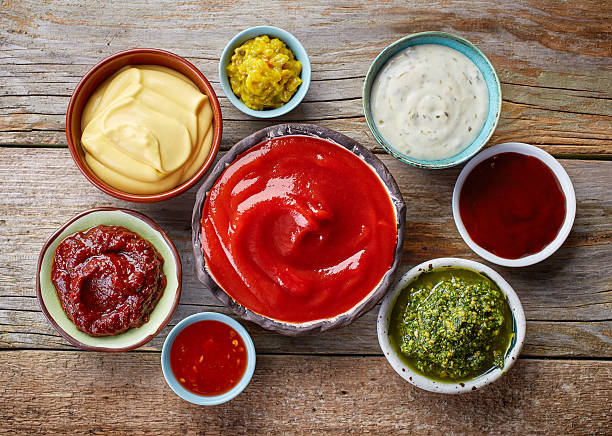Ketchup & Spreads: Essential Kitchen Staples
Ketchup and Spreads: The Multitasking Condiments of Any Kitchen
Condiments are key players in everyday meals, snacks, and even some creative cooking. Ketchup and spreads take the prize for becoming household staples, elevating the most mundane of dishes to unforgettable experiences. But from dipping French fries in ketchup to spreading a tangy mustard on a sandwich, these condiments do their work – bringing versatility, flavor, and convenience to the table. In this blog, we will explore their histories, varieties, uses, and recipes as a celebration of ketchup and spreads and their effects on global cuisine.

Origins of Ketchup and Spreads
Ketchup: The Fermented Fish Becoming a Tomato Classic
Ketchup is derived from the tomato but is hardly of that derivation. The word ketchup itself comes from the Chinese word ke-tsiap, which, back in the day, used to refer to a kind of sauce made of fermented fish. This savoury concoction was brought to Europe by voyagers in the 17th century and transformed into other varieties.
During early 18th century, ketchup was transformed into a sauce that made food spicy. British recipes used the term ketchup to signify mushrooms, walnuts and anchovies.
By the end of the 1800s, the recipes would further evolve into those adopted by Americans by adding tomatoes, sugar and vinegar to make the sweet and sour-tasting tomato ketchup.
Ketchup is not one of those stand-alone but is almost sure to have run close to filling every flavor imaginable from spicy to smoky and now even fruity.
Dips: Even for Everyone
Spreads are probably the first and most ancient vehicles of food culture for the world, with each nation displaying its individuality: i.e.
Butter and Cheese Spread: These two are probably the oldest spreads of all and mostly consumed with some types of bread or as first course cooking agents in such creamy forms.
Peanut butter is the most famous commercial of the decade, the first known occurrence of this product dating back to the end of the nineteenth century, but having achieved renown popularity and multitudes of consumers through its versatile uses and food value.
Fruit Preserves: It has always been a trend as the sweet topping for bread and pastries.
Savory Spreads: These are examples of how spreads are unique across the world: pesto from Italy, tapenade from France, and hummus from the Middle East.
General Variants of Ketchup and Other Spreads
1. Types of Ketchup
Classic Tomato Ketchup: The standard combination of tomatoes, sugar, vinegar, and spices is what makes this quintessentially sweet and tangy condiment.
Spicy: Of course for those who like it hot, spicy ketchup is further made with chili peppers or hot sauce.
Smoky Ketchup: Bold barbecue flavor added from smoke paprika or hickory.
Sweet Spread: Jam fruits, honey and chocolate-hazelnut spreads like Nutella.
The various uses of ketchup and many more spreads
Ketchup: The One and Only Genuine Favorite
This fact makes ketchup famous: versatility. These are their best-known applications:
Dip able: Ketchup makes a delicious dip paired with French fries, chicken nuggets and onion rings.
Sauces Base: Usually ketchup is the base for barbecue sauce, cocktail sauce and even sweet and sour sauce.
Burgers and Sandwiches: Its sweet and sour taste offsets the taste of meat, cheese and vegetables.
Glaze and Marinade: Because of its thick texture and delicious flavor, it’s perfect for glazing meatloaf or marinading anything grilled.
They Use it in Recipes: From little bites here and there potentially sweetening stews to being used in stir-fries for a tangy punch, ketchup seems to have a place in a lot of dishes.
There are best uses of spreads beyond the magical topping on bread.
Here is how to really think out of the box about them.
In Sandwiches and Wraps: Spreads add flavor and add moisture to sandwiches, from butter or mayonnaise to flavored pestos or hummus.
As a Dip: Cream cheese or nut butters can often serve as a fruit or cracker dip, or even as a vegetable stick dip.
In Baking: Cookies, cakes, and bars all have nut spreads such as peanut butter as key ingredients.
Pasta Sauces: Pesto, a sun-dried tomato spread, or even a garlic butter spread work wonders for pasta dishes.
As toppings: Sweet spreads turn pancakes, waffles, or desserts into treats with fruit jams or chocolate spreads.
In Appetizers: Spread tapenade on crostini; cream cheese with cooked topping makes a perfect filling for canapé.
Make Your Own Ketchup or Spread
Homemade ketchup and spreads are not only healthy but allow for individual choice in recipes. Here’s how to make one on your own:
Homemade Ketchup
Ingredients
2 lb ripe tomatoes; chopped
1/2 c vinegar
1/4 c sugar
1 tsp salt
1/2 tsp cinnamon
1/2 tsp cloves; ground
1/2 tsp paprika
Directions:
Blend tomatoes to form a smooth puree.
In a pot simmer the puree with vinegar, sugar, and spices until thickened.
Adjust seasonings to taste; store in a sterilized jar.
Nut butter recipe
These are the ingredients:
2 cups roasted peanuts or any nuts
1-2 tbsp honey
A pinch of salt
Procedure:
Put the roasted nuts into a food processor and blend till smooth, stopping to scrape sides when necessary.
Add honey and salt to taste, and blend some more.
Store in an airtight jar.
Health Question: how good are ketchup and those spreads for you?
There is no denying, ketchup and spreads are always palatable, but their nutrients vary:
Ketchup: Most store-bought ketchup is high in sugar and sodium. Low-sugar or homemade can be better alternatives.
Nut and seed spreads: They are the powerhouse of all nutrients, rich in healthy fats, protein, and vitamins but most have too much added sugar or oils in most commercially available varieties.
Sweet spreads: These are enticingly high in sugar and to be enjoyed in moderation: chocolate-hazelnut spread.
Vegetable-based: Some of the spreads from vegetables include hummus or those made with avocados. These are generally healthy and rich in nutrients.
Interesting Fact About Ketchup and Spreads
Ketchup as Medicine: Tomato ketchup was sold as a remedy for indigestion and other diseases in the early 1830s.
Largest Jar of Peanut Butter: Over 4,000 lb was what the largest jar of peanut butter weighs ever!
Ketchup-Packages: Over 11 billion ketchup packets have been utilized worldwide every year.
Pesto Origin: This names its Italian term “pestare,” what which means in English “to pound…is derived the way it is prepared”.
Conclusion
Ketchup and spreads are much more than condiments. They are actually culinary tools. They aid flavoring, adding texture and personality to food-a culinary delight. Be it a dipping of fries in ketchup, spreading the cream cheese version on a bagel, or stirring pesto into pasta: it has endless possibilities. A bit of playing around with homemade preparation can result in healthier, customized condiments that suit one’s tastes and dietary needs. So, grab your ingredients, unleash your creativity, and savor those flavorful worlds of ketchup and spread!

